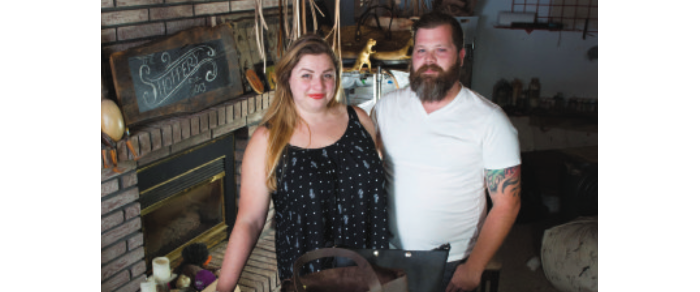Clean classic designs, bohemian simplicity with contemporary updates, few seams and one quality piece of imported leather is what differentiates The Shoppery's vision of handmade bags, totes and wallets ““ each designed with longevity and versatility in mind.
“At $350, this is an investment bag,” says Stephani Serdar, one half of the team at The Shoppery based in Burlington. “Ours are pieces for life that will carry you many years,” she adds.
Four years ago, Serdar and her husband Bryan Tupholme, started a business to complement their full-time jobs. But the business had a requirement: it must allow the couple a satisfying creative outlet. So they started designing with textiles and wooden furniture created from reclaimed barn board. Serdar says this rustic esthetic ““ much like their home filled with reclaimed wood furniture ““ evolved from creating fibre, wood and wool home décor products to crafting leather goods ““ specifically handbags, totes and accessories.
The change in medium from wood to leather almost two years ago happened by accident: “After 15 years together, gift giving gets a bit challenging,” Serdar says, “Bryan briefly expressed an interest in leatherwork.” On a whim, she bought her husband a leather crafting kit for his birthday, and the direction of their artisan efforts shifted.
Quality design is The Shoppery's focus. “All of our leather is sourced from South America, the United States and Italy by a Mississauga-based supplier.” Serdar says. “We use leather from cruelty-free companies and never from Asia because it's not good quality.”
Each piece is crafted from start to finish by either partner, but the process of perfecting the design is a collaborative effort. “One of us will come up with an idea or template, and then we discuss the idea behind it and how it might be improved.” Serdar says. Then either she or Tupholme complete the piece from cutting to stitching.
Notably, however, the latest modification to The Shoppery designs is done entirely by Serdar ““ and inspired by tie-dye. “Obviously, you can't tie-dye leather,” she says. “So, I thought “˜how can I recreate the same effect on leather?'” That question led to researching a process called paper marbling ““ a technique that floats coloured paints or dyes on a water or viscous surface then carefully transfers those colours to an absorbent medium like paper or fabric. Using a similar technique with leather dye, Serdar prints swirls of marbled colours onto the surface of leather.
Because pieces of leather have to be laid over the dye emulsion (like laying a stamp in ink), so far Serdar can only use the technique on small items such as wallets and clutches. Marbled totes and cross-body bags will be added later when the team finds a bigger studio space necessary to accommodate stamping a full leather hide.
Many Shoppery bag styles are cut from a single seamless piece of leather, including the first and still most popular design: the Beatrice, an over-the-shoulder tote-sized bag. This is their easiest design to create, but also the sturdiest and most functional. “Fewer seams mean stronger and better quality,” says Serdar.
In addition, The Shoppery pieces are designed to fit into each other ““ clutches go into totes, wallets fit into cross-body bags. They're also designed for multi-purposes. For instance, the envelope clutch can fit a Mac Book and the wrist pouche doubles as a make-up bag. Creating versatile, long lasting pieces is the goal.
Some The Shoppery products are sold the traditional way: in brick and mortar stores including Studio 205, Shine and Canoe in Hamilton, Ontario.
To view more visit the-shoppery.com
